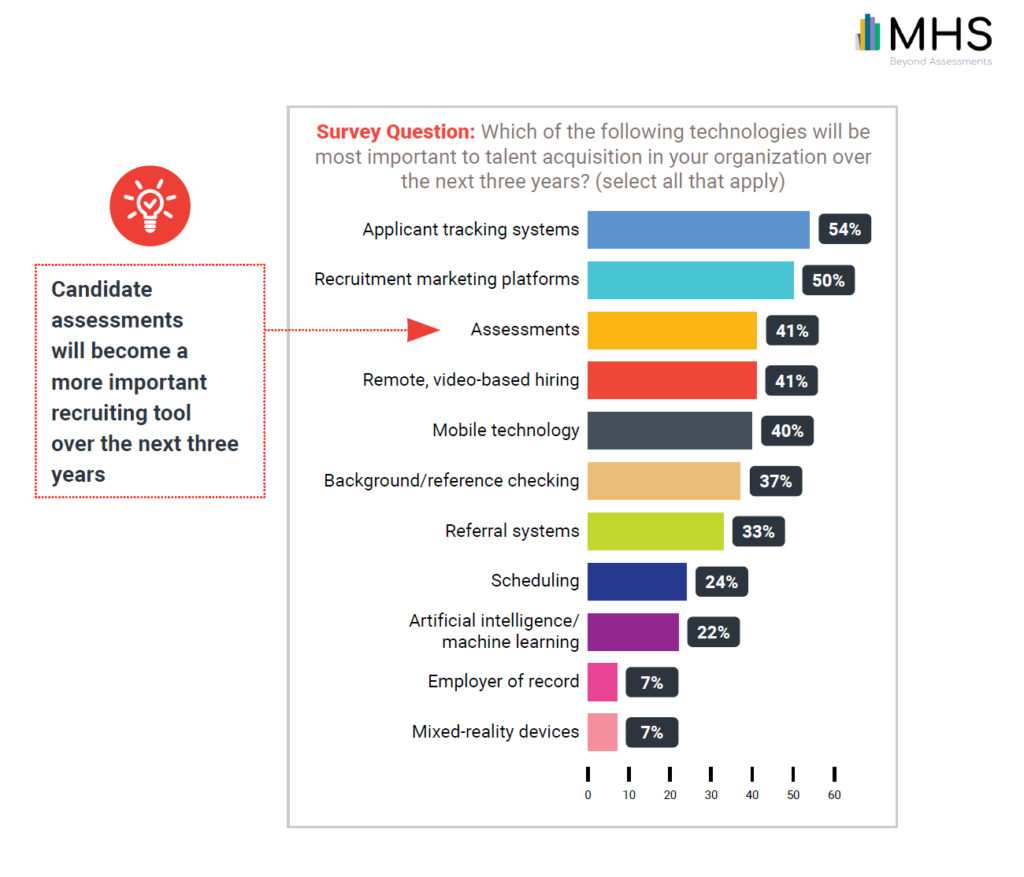The future of talent acquisition is fueled by technology
In August 2021 U.S. unemployment dropped to 5.4%. Despite ongoing waves of COVID-19 and its variants, more people are expected to re-enter the workforce as governments around the world cease providing financial relief linked to the pandemic.
Experts expect intense competition for talent, further exacerbating the difficulty of recruiting top-notch talent which has risen to our collective consciousness as “The Great Resignation.”
Recruiting specialists are gearing up their talent acquisition processes, priorities, and technologies, to keep their businesses running smoothly. To aid recruiting specialists in what may quickly become the single most critical role in their organizations, HR.com recently undertook a survey to get a snapshot of what talent acquisition looks like in its current state and what HR professionals think it will look like in the future.
The Future of Talent Acquisition survey (a sponsored partnership between MHS and HR.com) gathered 210 complete and partial responses from HR professionals in virtually every industry vertical. Respondents are located worldwide, but most of them reside in North America. The participants represent a broad cross-section of employers by number of employees, ranging from small businesses with fewer than 50 employees to enterprises with 20,000+ employees. Questions for the survey were guided by an independent advisory board of talent acquisition experts, who we thank for their insights.
Taking a closer look at current trends and interesting predictions in talent acquisition
1. Few HR professionals give their organizations high marks in terms of the maturity of their talent acquisition functions.
- Only 18% percent say their talent acquisition function is advanced or top-notch.
- About half say their talent acquisition function is progressing whereas 29% say it is either improvisational or chaotic
2. A wide variety of factors hinder and drive talent acquisition
- The need to hire quickly is the most widely cited driver of talent acquisition efforts, at 63%, closely followed by the need to add enough workers to support growth, at 62%.
- The biggest barriers to talent acquisition success are not being able to find the talent that meets the job requirements (61%) and not having the right skills in the applicant pool (46%).
3. Recruiting technologies are key to talent acquisition now and will become even more important in the future:
- The most widely used and accessed technologies today are:
- applicant tracking systems (ATS)
- video interviewing technologies
- referral systems and platforms
- The technologies that will be most important to talent acquisition over the next three years are:
- ATS
- recruitment marketing platforms
- assessments
- remote, video-based hiring
4. Over the next three years, artificial intelligence (AI) will have the largest influence in four areas:
- automating talent acquisition processes
- targeting candidate searches
- prioritizing resumes and applications
- engaging candidates
5. Respondents say that over the next three years, three key talent acquisition goals will stand out:
-
- maintaining a quality and engaged pool of possible candidates
- staying as agile as possible to react quickly
- cultivating a stronger employer brand
6. These four areas were identified as places where improvements will be most important:
-
- more focus on quality candidates
- more ability to source and hire diverse candidates
- improved productivity and efficiency
- more strategic talent acquisition that aligns with corporate goals
- Technology is driving change in the talent acquisition space
Technology is driving change in the talent acquisition space
There are many recruiting technology applications available, most promising to increase the quality and quantity of candidates as well as recruiting efficiency. Categories include applicant tracking systems, candidate marketing systems, screening/assessment tools, video interviewing platforms and onboarding tools, to name a few. Many of these applications have a long history and are updated regularly. Some, like employee referral systems, are newer on the scene.
Fifty-three percent of responding organizations report using an applicant tracking system. Other frequently used technology applications include video interviewing (41%), performance management (41%) and referral systems (39%). Given the increase in the need for remote-based hiring, it is not surprising to see a greater use of video interviewing technology than in the past.
Fifty-four percent say applicant tracking systems (ATS) will be among the most important technologies for talent acquisition over the next three years. This suggests that ATS will continue to be the backbone of many recruitment functions, enabling organizations to collect, organize and track candidates through the entire hiring process more easily.
Nearly as many respondents (50%) say recruitment marketing platforms will be important to talent management over the next three years. These platforms can allow organizations to better reach, attract and source qualified candidates. They can also help the organization measure the effectiveness of their sources and channels so that they can make more informed decisions about recruitment marketing strategies and budget.
Finally, forty-one percent of respondents say candidate assessments will receive more importance in the future. Applicant testing and assessment tools have been around for decades, but it is only recently that they have become more automated, allowing organizations to administer validated skill-level and competency screens far more quickly and at a lower cost.
Ideas and tips for improving your current talent acquisition practices
- Embrace new validated recruiting technologies when they can improve efficiency and effectiveness. Technologies will continue to evolve in this area. Newer applications include more robust job aggregators, predictive analytics using AI, online testing and assessments, video interviewing platforms, applicant management, and programmatic job advertising. As your organization adopts new technologies, consider how they can best be integrated with one another. This will allow for better analytics and deeper insights into the recruitment process.
- Prioritize both speed and quality. In the current labor market, employers must act quickly to hire good candidates. But quality is as important as speed. Great talent can improve productivity and efficiency in an organization. Identify current roles that did not exist or were unfilled within the past few years and illustrate how filling those positions with great hires promoted the ongoing growth and success of the organization. Such a narrative can form the basis of a compelling business case to make hiring the best talent a high priority. Organizations must find the best ways of balancing both speed and quality.
- Establish clear goals for your recruiting efforts and measure them. Organizations that use a variety of metrics tend to have more effective recruiting systems. Without these metrics, recruiters are doing their jobs blindfolded, unable to get a handle on what is working and what is not. Compared to other HR systems, many recruiting metrics are easy to put in place (e.g., time to hire, retention, and source of hire). However, it is important to ensure a close link between the metric and the strategic goals of the organization. For example, a new start-up might require staffing up a large volume of hires in a short period of time. On the other hand, if you have a customer care team with extremely high turnover, longer-term retention might be the most critical metric. With clearly aligned goals, you can develop a data-based narrative about TA’s contribution to plans. TA can align with corporate goals in multiple ways. Higher sales might require additional skilled sales professionals. Developing new products might require hiring software developers, project managers and marketing professionals. Identify where and how successful recruitment furthers organizational and departmental goals and measure success against these efforts.
- Upskill your recruiting team. The quality of your talent depends on the effectiveness of your recruiting function, and, in turn, your recruiting team. It is not an easy job. Effective recruiters need a host of behavioral competencies such as the ability to influence, attention to detail, excellent decision-making and more. But they must also master a host of other skills such as marketing ability, tech-savviness, data fluency, and strategic thinking. Given the importance of this role, take a close look at the strengths and development needs of your team and provide support to close the skill gaps. Consider partnering with your organization’s learning and development department to enhance current skills or train for new recruitment skills.
- Evaluate where and how you find your best employees. Identify your best employees and find out where your recruiters found them. How can you engage similar candidates in the recruitment process? Do all your quality hires come from the same source? Tap into the sourcing channels that raise the odds of finding your next great hires and consider using new approaches, such as programmatic advertising. However, remember you may have to recruit in multiple channels depending upon the talent needed.
- Audit the current skills within your organization. Compare your organization’s current in-house skills to the ones currently required and to the skills you will need three years from now. Where are the gaps? Do you anticipate creating new roles to address innovation, growth, new markets, new products, or meet competitive challenges? Do you have employees who have proven their ability to learn and master new skills and technologies? Once you understand the gaps between what skills your organization has and the skills your organization will need, you can develop strategic talent acquisition goals to recruit the right talent to fill those skill gaps.











